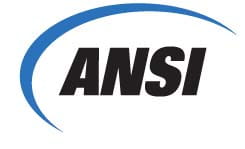US – ANSI Z87.1
Being better than standard is our standard
 For
protective eyewear in the US, the governing document is ANSI Z87.1, and although revised in 2003, 2010 and again recently in
2015, for 40 years, ANSI has remained a base point from which we all begin to qualify our protective eyewear. However, did
you know that In the United States, compliance with the standard is self-certified?
For
protective eyewear in the US, the governing document is ANSI Z87.1, and although revised in 2003, 2010 and again recently in
2015, for 40 years, ANSI has remained a base point from which we all begin to qualify our protective eyewear. However, did
you know that In the United States, compliance with the standard is self-certified?
The certification is based on test results generated by the manufacturer as part of its initial design and ongoing Quality Control
procedure. However, no independent certification is required. And zero ongoing certification is considered essential. Molds
may change, the factory and equipment manufacturing the products may change, or the tolerances of the equipment itself can
change.
What won’t change it that products that at some point met the standard will continue to carry a “Z87+” marking on
the lens(es) and frame. Brass Knuckle thinks this is outrageous.
We test at the manufacturing level and then continue to test in independent, ISO certified laboratories in the United States. We pull products every year that, for some reason, fail to meet our higher standards. This is our minimum standard and we’re pretty sure it’s a bit higher than most.
The Test
In the current edition of the standard is Z87.1-2015, the following “high” impact tests apply to lenses, as well as to
the frames or product housing:
- A lens retention test is conducted via a “high mass” impact. A pointed 500 gm (1.1 lb) projectile is dropped 50
inches onto the complete protector mounted on a headform. No pieces can break free from the inside of the
protector, the lens cannot fracture, and the lens must remain in the frame or product housing. This test is a
good measure of the product’s strength, simulating a blow such as from a tool that slips from the work surface
or when the lens collides with stationary objects. - A high velocity test is conducted, at 6 specified impact points, where the projectile is a ¼ inch steel ball
traveling at specific speeds depending upon the type of protector. For spectacles, the velocity is 150 ft/sec
or 102 mph. The pass/fail criteria are the same as for the high mass test, plus no contact with the eye of
the headform is permitted through deflection of the lens. This is meant to simulate particles that would be
encountered in grinding, chipping, machining or other such operations.
Questions about ANSI/ISEA 105-2016 or Brass Knuckle® products?
Call us at 770.674.8930